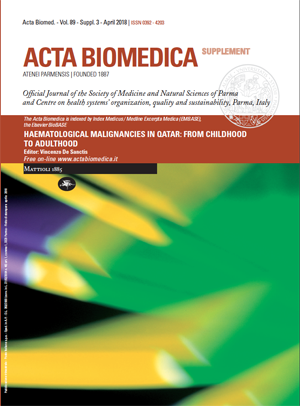Chronic Myeloid Leukemia with cryptic Philadelphia translocation and extramedullary B-lymphoid blast phase as an initial presentation
Keywords:
Chronic Myeloid Leukemia, Cryptic Ph translocation, Extramedullary B-lymphoid blast phaseAbstract
Chronic Myeloid Leukemia (CML) is a clonal myeloproliferative neoplasm (MPN) characterized by the presence of a reciprocal translocation between the long arms of chromosomes 9 and 22, t(9;22)(q34:q11), resulting in fusion of the break point cluster region (BCR) with the ABL gene, which forms an oncogene, the transcript of which is an oncoprotein with a tyrosine kinase function. In the great majority of CML; BCR/ABL1 is cytogenetically visualized as t(9;22); giving rise to the Ph chromosome, harboring the chimeric gene. Cryptic or masked translocations occur in 2–10% patients with no evidence for the BCR/ABL rearrangement by conventional cytogenetics but are positive by Fluorescence in Situ Hybridization (FISH) and/or reverse transcriptase polymerase chain reaction (RT-PCR). These patients are described as Philadelphia negative (Ph negative) BCR/ABL1- positive CML with the chimeric gene present on the derivative chromosome 22, as in most CML cases, or alternatively on the derivative 9 in rare occasions. In the majority of cases, CML is diagnosed in the chronic phase; it is less frequently diagnosed in accelerated crises, and occasionally, its initial presentation is as acute leukemia. The prevalence of extramedullary blast phase (BP) has been reported to be 7–17% in patients with BP. Surprisingly, no extramedullary blast crises of B- lymphoid lineage have been reported before among cases of CML as the initial presentation. We report an adult male diagnosed as CML- chronic phase when he was shortly presented with treatment-naive extramedullary B-lymphoid blast crises involving multiple lymph nodes, with no features of acceleration or blast crises in the peripheral blood (PB) and bone marrow (BM). In addition the patient had variant/cryptic Philadelphia translocation. This is the first report of CML, on the best of our knowledge, with extramedullary B-lymphoid blast phase, as initial presentation, that showed a cryptic Ph translocation
Downloads
Published
Issue
Section
License
This is an Open Access article distributed under the terms of the Creative Commons Attribution License (https://creativecommons.org/licenses/by-nc/4.0) which permits unrestricted use, distribution, and reproduction in any medium, provided the original work is properly cited.
Transfer of Copyright and Permission to Reproduce Parts of Published Papers.
Authors retain the copyright for their published work. No formal permission will be required to reproduce parts (tables or illustrations) of published papers, provided the source is quoted appropriately and reproduction has no commercial intent. Reproductions with commercial intent will require written permission and payment of royalties.







